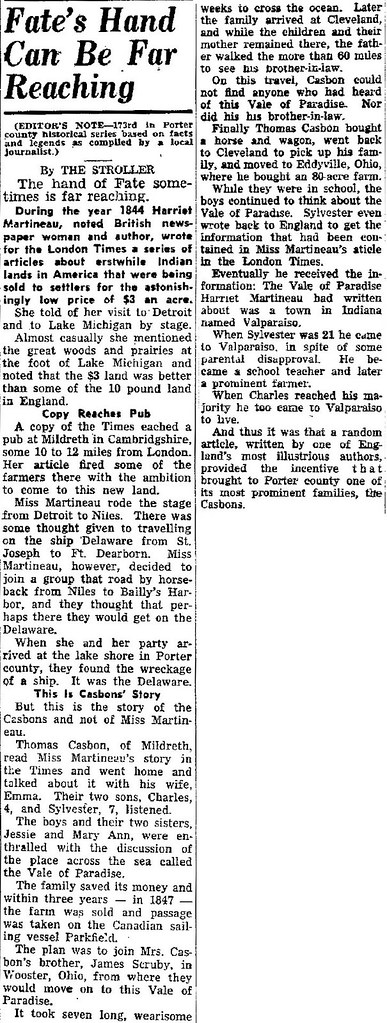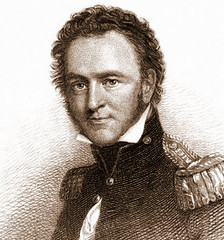This is a brief interlude in the ‘From England to Indiana’ series of posts. Now that Thomas Casbon and his family have arrived in Indiana, I thought it would be a good time to step back and look at the story from a different perspective.
Growing up, I always considered Indiana the ancestral home. It’s where we went to see “the farm” and to visit my Dad’s relatives. Until I started researching my family history, I never gave much thought to where the family came from before Indiana. Of course, now I know that we originated in Meldreth, England, and spent time in Ohio before finally settling in Indiana.
This raises a basic question: why did they do it? Why did Thomas decide to leave England? Why did he go to Ohio? Why did he leave Ohio (when he was over 60 years old) for Indiana?
Let me assure my readers that I don’t know all the answers to these questions. Future posts in the series will give some insights about why he left England and went to Ohio. With this post and the next I’ll look at why Thomas went to Indiana.
Let’s start with a newspaper clipping that I’ve had for a number of years.

“Fate’s Hand Can Be Far Reaching.” The Vidette-Messenger. Valparaiso, Indiana, 22 March 1957. Newspaper Archive http://ezproxy.ppld.org:2083/us/indiana/valparaiso/valparaiso-vidette-messenger/1957/03-22/ (Click on image to enlarge)
I really like this story. For many years I assumed it was a factual account of my family’s journey. However, once I started to ‘fact-check,’ I realized that a lot of things didn’t add up. After more research I’ve concluded that the author (The Stroller) took three different stories and skillfully combined them into one tale.
The first story is about the British author Harriet Martineau (1802-1876). She is a fascinating person, a woman who found success in a man’s world, writing about all manner of social topics including politics, economics, religion, the family, and slavery. These days she would be considered a feminist and social activist.

In 1834 (not 1844 as stated in the article), she began a 2-year tour of the United States, including the new states of the “Northwest” – Ohio, Michigan, Indiana, Illinois, and Wisconsin. She later published two books about her travels, Society in America (1837) and Retrospect of Western Travel (1838). These books can be found online on Google Books and other sites, and are very interesting reading.
The Stroller must have had access to a copy of Society in America, because he accurately portrays Miss Martineau’s description of her travels from Detroit to Michigan City, and then across the northernmost portion of Porter County (although she does not name the county) on her way to Chicago. She gives a brief description of Door Prairie, near La Porte, Indiana, as well as the Indiana Dunes.
Although his description of her travels is accurate, the implication that she described the area as a Vale of Paradise. is not. Harriet Martineau never used the term Vale of Paradise to describe Indiana or any other location in her travels.
This brings me to the second story woven into The Stroller’s tale, i.e., how the city of Valparaiso got its name. Porter County was established by the Indiana General Assembly in early 1836.[1] The county was named for Commodore David Porter (1780-1843), who gained fame during the War of 1812 as commander of the USS Essex. [2] A committee selected the location for the new county seat and named it Portersville.[3] In 1837 the town was renamed Valparaiso, which means ‘Vale of Paradise’ in Spanish. This was also done to honor Commodore Porter, who gained fame in the naval Battle of Valparaiso, Chile.

According to local legend, the name of Valparaiso came about when a group of marines and sailors from the South Pacific Ocean started telling stories in Hall’s Tavern in Portersville. Their tales included the Chilean seaport of Valparaiso, where Commodore Porter fought his battle. One of those present in the tavern suggested renaming the county seat after the place of the battle, and this led to a bill in the General Assembly making the name change official.[4]
The third story used by The Stroller is the actual story of Thomas Casbon’s journey from England to Indiana. This narrative is based on earlier published sources. Although basic elements of the story are factual, he exercised a great deal of creative license in order to weave the other two stories into this one.
First of all, the story of Thomas reading about the Vale of Paradise in a Meldreth pub is probably a myth. As I said above, Harriet Martineau never used the term Vale of Paradise, and to the best of my knowledge, she did not write about her travels in The London Times or any other newspaper (believe me, I’ve looked!). Even if she had done so, recall from an earlier post that Thomas signed his marriage record with his mark, suggesting that he was not proficient at reading or writing. This just doesn’t mesh with the description of him casually reading The Times. It’s possible that he read Harriet Martineau’s book, or that someone read it to him, but I don’t think it’s likely. It’s almost impossible that he learned of a place called the Vale of Paradise before leaving England.
Also, it seems highly unlikely that Thomas sold a farm in England before coming to America. His occupation in 1841 was Agricultural Labourer[5], meaning he was in the lower rungs of society and not a landowner. Another error made by The Stroller is to describe Thomas and Emma’s son Jesse as a daughter, Jessie.
The Stroller’s claim that Thomas and his family were motivated to come to Indiana based on reading about Harriet Martineau’s description of a Vale of Paradise is simply false. The truth is a bit more complicated than that, and will be the subject of the next post.
After digging into this story, I decided I wanted to know a little more about The Stroller and where he got his information. It turns out his name was William O. Wallace, a journalist and historian who wrote more than 700 Stroller articles in the Vidette-Messenger between 1956 and 1962. He used “ingenuity and creativity to eliminate the usual ‘dryness’ of historical accounts. …Dressed up in an original Wallace styling, his accounts carried a triple impact to his readers, containing true historical matter, some partially true, and some legendary.”[6]
That certainly describes his version of Thomas Casbon’s story. Unfortunately, he left it to the reader to determine which parts are true and which parts are legendary. Nevertheless, it is entertaining reading.
Do any of my readers remember The Stroller? I think if there had been an internet at the time, William O. Wallace would have been a blogger!
